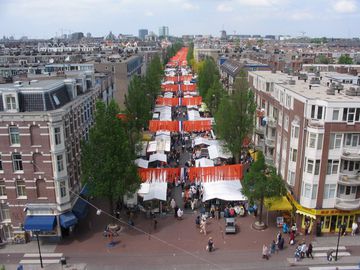

This market is located along the Dapperstraat, located in the city neighborhood that attracts many newcomers - immigrants from Surinam, Africa, Asia and, more recently, Eastern Europe. In 2007, the National Geographic Traveler named the Dappermarkt one of the Top 10 Shopping Streets in the World, just after such globally reputed places as the Grand Bazaar in Istanbul and Navigli Antique Market in Milan. The Dappermarkt reflects the multi-cultural neighborhood in being bustling, international and out-of-the-ordinary.
The market is great place for those looking for a bargain. It has 250 stands occupied by 160 vendors and it is visited by 15,000 people daily. On both sides it is surrounded by cafés - ranging from traditional 'brown' cafes as well as ethnic and the hip young ones - and stores selling everything from clothes, shoes, and exotic food to jewelry and electronics.
The market's website lists cultural events that are occasionally organized along the market: live music, concerts and festivals, and such events as the International Women's Day on March 8th are celebrated here. The market is open Monday through Saturday 9 am - 5 pm and is closed on Sundays.
The market lies in the middle of the vibrant, colorful and multicultural Dapperbuurt. This former working class district has a rich architectural and cultural history dating back to the 19th century. The Dapper Market is strongly influenced by the social relations in the neighborhood and is, therefore, declared to be a genuine Amsterdam folk market. The Dapperbuurt was named after the 17th-century physician and writer Olfert Dapper. Although he had never set foot outside of Europe, he wrote many influential books on history and geography and his description of Africa is still referred to regularly by contemporary sociologists. In fact, many streets in the neighborhood are named after historians.
Karel Appel, the renowned CoBrA artist of international repute was born in the Dapperstraat in 1921. The building at number 7 has now been transformed into a short-term residency for local and international artists studying at the Rijkskademie (State Art Academy) not far from here at Sarphatistraat, the art school where Karel Appel had also studied himself. The house is open to visitors and there are some works by both the residents and Appel which date back to his time as one of the neighborhood denizens.